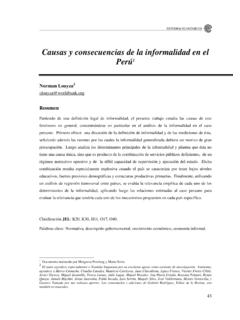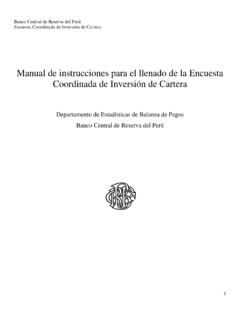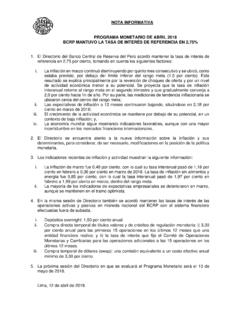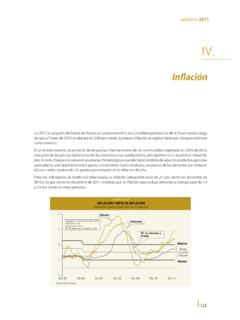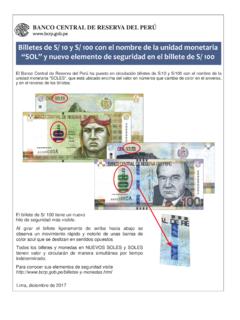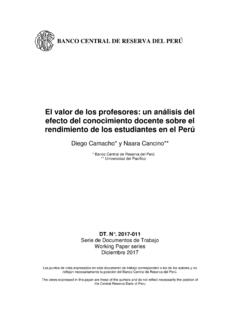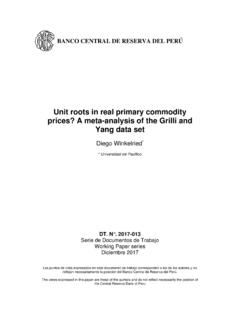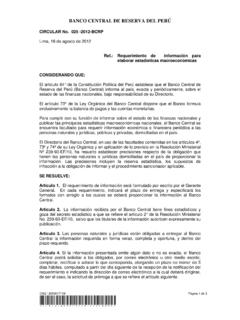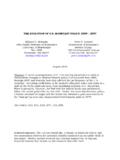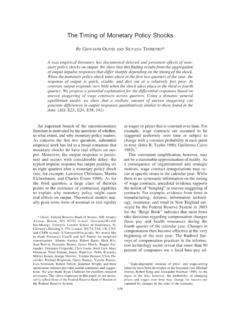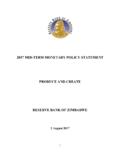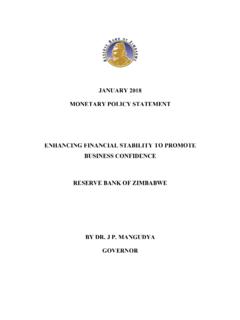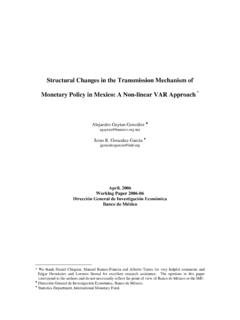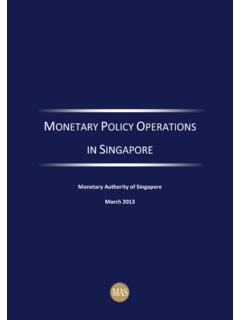Transcription of Monetary policy spillovers, global commodity …
1 DT. N 2018-002 Serie de Documentos de Trabajo Working Paper series Febrero 2018 Los puntos de vista expresados en este documento de trabajo corresponden a los autores y no reflejan necesariamente la posici n del Banco Central de Reserva del Per . The views expressed in this paper are those of the authors and do not reflect necessarily the position of the Central Reserve Bank of Peru. BANCO CENTRAL DE RESERVA DEL PER Monetary policy spillovers, global commodity prices and cooperation Andrew Filardo1, Marco Lombardi1 Carlos Montoro2 and Massimo Ferrari3 1 Bank for International Settlements 2 Banco Central de Reserva del Per y Ministerio de Economia y Finanzas 3 Universit Cattolica del Sacro Cuore 1 Monetary policy spillovers, global commodity prices and cooperation1 Andrew Filardo2, Marco Lombardi2.
2 Carlos Montoro3 and Massimo Ferrari4 Abstract How do Monetary policy spillovers complicate the trade-offs faced by central banks face when responding to commodity prices? This question takes on particular relevance when Monetary authorities find it difficult to accurately diagnose the drivers of commodity prices. If Monetary authorities misdiagnose commodity price swings as being driven primarily by external supply shocks when they are in fact driven by global demand shocks, this conventional wisdom to look through the first-round effects of commodity price fluctuations may no longer be sound policy advice.
3 To analyse this question, we use the multi-country DSGE model of Nakov and Pescatori (2010) which breaks the global economy down into commodity -exporting and non- commodity -exporting economies. In an otherwise conventional DSGE setup, commodity prices are modelled as endogenously changing with global supply and demand developments, including global Monetary policy conditions. This framework allows us to explore the implications of domestic Monetary policy decisions when there is a risk of misdiagnosing the drivers of commodity prices. The main findings are: i) Monetary authorities deliver better economic performance when they are able to accurately identify the source of the shocks, ie global supply and demand shocks driving commodity prices; ii) when they find it difficult to identify the supply and demand shocks, Monetary authorities can limit the deterioration in economic performance by targeting core inflation.
4 And iii) the conventional wisdom approach of responding to global commodity price swings (as external supply shocks when they are truly global demand shocks) results in an excessive procyclicality of global inflation, output and commodity prices. In light of recent empirical studies documenting a significant role of global demand in driving commodity prices, we conclude that the systematic misdiagnoses inherent in the conventional wisdom applied at the country level have contributed to destabilising procyclicality at the global level. These findings support calls for greater attention to global factors in domestic Monetary policymaking and highlight potential gains from greater Monetary policy cooperation focused on accurate diagnoses of domestic and global sources of shocks.
5 Keywords: commodity prices, Monetary policy , spillovers, global economy. JEL classification: E52, E61. 1 We thank conference participants at the Central Bank of Brazil s XVII Annual Inflation Targeting Seminar, CEMLA s XX Annual Meeting and CEBRA s 2017 Annual Meeting. We also thank seminar participants at the Bank for International Settlements, the Bank of Canada and Bank of Japan for their comments. The views expressed here are those of the authors and do not necessarily reflect those of the Bank for International Settlements, the Central Reserve Bank of Peru.
6 2 Bank for International Settlements. 3 Central Reserve Bank of Peru and Ministry of Economy and Finance of Peru. 4 Universit Cattolica del Sacro Cuore. 2 I. Introduction Over the past decade, global commodity prices have experienced wide swings, reaching historically high levels in the run-up to the Great Recession before plummeting as the global economy collapsed. Prices subsequently rebounded with the global economic recovery but, more recently, commodity prices have fallen again amid significant policy concerns. While challenging, this type of volatility is not a new environment for policymakers.
7 Even though most commodity prices remained broadly stable during the so-called Great Moderation, they were quite volatile in the 1970s amid geopolitical tensions that pushed oil price volatility to then unprecedented levels. It was the experience of the 1970s that forged the conventional wisdom about how Monetary authorities should respond to commodity price fluctuations. commodity price fluctuations were seen largely as the result of exogenous supply shocks; in such an environment, the conventional wisdom that emerged was that, when facing such swings, Monetary authorities should look through the first-round price effects and only respond to the second-round effects on wage and inflation expectations.
8 In practice, this suggested a Monetary policy focus on core inflation. Views about the drivers of global commodity price swings have been evolving, especially in recent years, as a growing body of statistical evidence points to a new interpretation of commodity price swings. Kilian (2009), for example, finds evidence that oil price fluctuations have been increasingly influenced by demand from commodity -hungry emerging market economies (EMEs). The most recent literature has not challenged this view: Kilian and Baumeister (2016) argue that the oil price decline in 2015 should also be ascribed to a slowdown in global economic activity; and Stuermer (2017) and Fukei et al (2018) emphasises the role of demand shocks in a historical perspective.
9 In a similar vein, Sussman and Zohar (2017) report that commodity price fluctuations can be taken as a proxy for global demand. In a broader context, Filardo and Lombardi (2013) note the growing prominence 3 of these global demand shifters for EME inflation dynamics. This new evidence raises doubts about the relevance of the conventional wisdom and may even suggest that the exogenous supply shock view is not only misleading but actually contributing to global economic and financial instability. The prominence of endogenous commodity price swings has important implications for Monetary policy , given the central role of Monetary policy in influencing aggregate demand.
10 The relationship between Monetary policy decisions and endogenous commodity prices implies an important two-way link. Monetary policy decisions influence aggregate demand and hence commodity prices. Indeed, Filardo and Lombardi (2013) and Anzuini et al (2013) report evidence that loose Monetary policy has had an impact on commodity prices via the global demand At the same time, commodity price swings influence price stability and hence Monetary policy decisions. This two-way relationship can operate to stabilise the economy under certain conditions and de-stabilise the economy under others.
